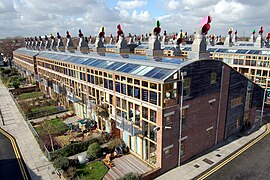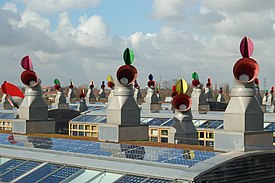
Wood gas is a fuel gas that can be used for furnaces, stoves, and vehicles. During the production process, biomass or related carbon-containing materials are gasified within the oxygen-limited environment of a wood gas generator to produce a combustible mixture. In some gasifiers this process is preceded by pyrolysis, where the biomass or coal is first converted to char, releasing methane and tar rich in polycyclic aromatic hydrocarbons.

Gasification is a process that converts biomass- or fossil fuel-based carbonaceous materials into gases, including as the largest fractions: nitrogen (N2), carbon monoxide (CO), hydrogen (H2), and carbon dioxide (CO2). This is achieved by reacting the feedstock material at high temperatures (typically >700 °C), without combustion, via controlling the amount of oxygen and/or steam present in the reaction. The resulting gas mixture is called syngas (from synthesis gas) or producer gas and is itself a fuel due to the flammability of the H2 and CO of which the gas is largely composed. Power can be derived from the subsequent combustion of the resultant gas, and is considered to be a source of renewable energy if the gasified compounds were obtained from biomass feedstock.

Cogeneration or combined heat and power (CHP) is the use of a heat engine or power station to generate electricity and useful heat at the same time.
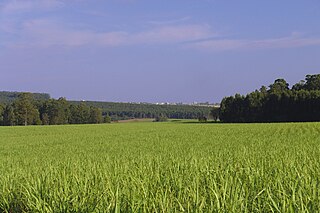
Bioenergy is energy made from biomass, which consists of recently living organisms, mainly plants. Types of biomass commonly used for bioenergy include wood, food crops such as corn, energy crops and waste from forests, yards, or farms. The IPCC defines bioenergy as a renewable form of energy. Bioenergy can either mitigate or increase greenhouse gas emissions. There is also agreement that local environmental impacts can be problematic.

Pellet fuels are a type of solid fuel made from compressed organic material. Pellets can be made from any one of five general categories of biomass: industrial waste and co-products, food waste, agricultural residues, energy crops, and untreated lumber. Wood pellets are the most common type of pellet fuel and are generally made from compacted sawdust and related industrial wastes from the milling of lumber, manufacture of wood products and furniture, and construction. Other industrial waste sources include empty fruit bunches, palm kernel shells, coconut shells, and tree tops and branches discarded during logging operations. So-called "black pellets" are made of biomass, refined to resemble hard coal and were developed to be used in existing coal-fired power plants. Pellets are categorized by their heating value, moisture and ash content, and dimensions. They can be used as fuels for power generation, commercial or residential heating, and cooking.
Domestic housing in the United Kingdom presents a possible opportunity for achieving the 20% overall cut in UK greenhouse gas emissions targeted by the Government for 2010. However, the process of achieving that drop is proving problematic given the very wide range of age and condition of the UK housing stock.

Hackbridge is a suburb in the London Borough of Sutton, south-west London, just over two miles north-east of the town of Sutton itself. It is 8.8 miles (15 km) south-west of Charing Cross.

Biomass (for energy) is matter from recently living (but now dead) organisms which is used for bioenergy production. Examples include wood, wood residues, energy crops, agricultural residues, and organic waste from industry and households. Wood and wood residues is the largest biomass energy source today. Wood can be used as a fuel directly or processed into pellet fuel or other forms of fuels. Other plants can also be used as fuel, for instance corn, switchgrass, miscanthus and bamboo. The main waste feedstocks are wood waste, agricultural waste, municipal solid waste, and manufacturing waste. Upgrading raw biomass to higher grade fuels can be achieved by different methods, broadly classified as thermal, chemical, or biochemical.

Biomass heating systems generate heat from biomass. The systems fall under the categories of direct combustion, gasification, combined heat and power (CHP), anaerobic digestion, aerobic digestion. The types of biomass heating are fully automated, semi-automated, pellet-fired, and combined heat and power.
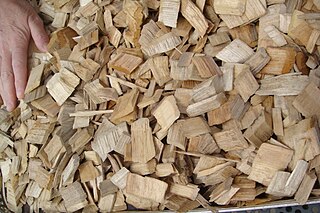
Woodchips are small- to medium-sized pieces of wood formed by cutting or chipping larger pieces of wood such as trees, branches, logging residues, stumps, roots, and wood waste.
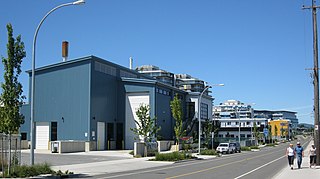
Dockside Green is a 1,300,000-square-foot (120,000 m2) mixed-use community in Victoria, British Columbia, Canada owned by Vancity Credit Union and noted for its strict adherence to the principles of sustainable architecture or green building.

The London Borough of Croydon has a wide variety of buildings mainly from post-war through to modern. Much of the modern architecture in the borough is centred on the commercial centre of the town, with much of the Victorian designs spread out on both the northern and southern corridors of the borough. Many former warehouses and factories have been converted for other uses changing the external appearance of Croydon erratically.
Bioregional is a British entrepreneurial charity, which aims to invent and deliver practical solutions for sustainability. It was founded in 1992 on the belief that overconsumption of resources was the driving force behind environmental degradation, and set out to find new ways for people to meet more of their needs from local resources.

Torrefaction of biomass, e.g., wood or grain, is a mild form of pyrolysis at temperatures typically between 200 and 320 °C. Torrefaction changes biomass properties to provide a better fuel quality for combustion and gasification applications. Torrefaction produces a relatively dry product, which reduces or eliminates its potential for organic decomposition. Torrefaction combined with densification creates an energy-dense fuel carrier of 20 to 21 GJ/ton lower heating value (LHV). Torrefaction makes the material undergo Maillard reactions. Torrefied biomass can be used as an energy carrier or as a feedstock used in the production of bio-based fuels and chemicals.
Both the public and private sectors in the United Kingdom promote green building. Presently, there are already regulatory mechanisms in place that establish Britain's commitment to this kind of building construction. The government, for instance, set out a target that by 2016, all new homes will have zero carbon emission and it also includes a progressive tightening of energy efficiency regulations by 25 percent and 44 percent in 2010 and 2013, respectively. The UK Building Regulations set requirements for insulation levels and other aspects of sustainability in building construction.
William Robert Dunster OBE is a British architect.
Maine Energy Systems (MESys) was founded in summer 2008 by Les Otten, Dutch Dresser, and others to aid in the transition to alternative energy in the northeastern United States. The company delivers wood pellets in bulk and sells fully automated wood pellet boilers for hydronic heating. MESys has been involved in numerous academic studies, work with political groups concerned with the environmental and economic aspects of residential and light commercial heating, and works with American regulatory bodies concerned with the safety of heating appliances.
The circulating fluidized bed (CFB) is a type of Fluidized bed combustion that utilizes a recirculating loop for even greater efficiency of combustion. while achieving lower emission of pollutants. Reports suggest that up to 95% of pollutants can be absorbed before being emitted into the atmosphere. The technology is limited in scale however, due to its extensive use of limestone, and the fact that it produces waste byproducts.

The Biomass Research and Demonstration Facility uses biomass to create clean heat and energy. This facility is located at 2329 West Mall in Vancouver at the University of British Columbia's West Point Grey Campus. Official operation began in September 2012, by combining syngas and gasification conditioning systems with a Jenbacher engine. The highest potential output of this system is 2 MWe (megawatts) of electricity and 9600 lbs of steam per hour. This system is the first of its type in all of Canada, and it was put together by the cooperation of three parties: General Electric (GE), Nexterra, and the University of British Columbia (UBC).
All Power Labs (APL) is a renewable energy company based in Berkeley, California. The firm designs and manufactures biomass gasifiers and builds and markets small-scale (15–150 kW) electrical generators fueled by these gasifiers. By 2013, they reached an installed base of 500 machines in approximately 40 countries; As of 2015, APL employed 30 staff, including engineering, manufacturing, management, sales, and technical support staff, on the site of the former Shipyard, an approximately 20,000 sq.ft. facility that includes APL’s offices, R&D, manufacturing and production facilities.
